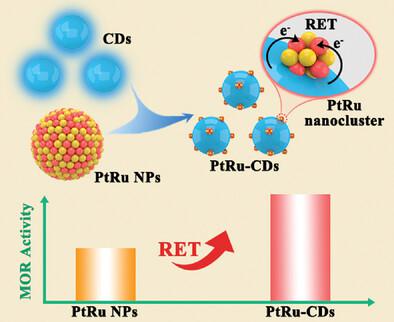Our official English website, www.x-mol.net, welcomes your
feedback! (Note: you will need to create a separate account there.)
Boosting the Methanol Oxidation Reaction Activity of Pt–Ru Clusters via Resonance Energy Transfer
Small ( IF 13.0 ) Pub Date : 2023-05-17 , DOI: 10.1002/smll.202302149 Jiahui Liang 1 , Heyun Cheng 1 , Bolin Zhao 1 , Qiong Hu 1 , Zihao Xing 2 , Yuwei Zhang 1 , Li Niu 1
Small ( IF 13.0 ) Pub Date : 2023-05-17 , DOI: 10.1002/smll.202302149 Jiahui Liang 1 , Heyun Cheng 1 , Bolin Zhao 1 , Qiong Hu 1 , Zihao Xing 2 , Yuwei Zhang 1 , Li Niu 1
Affiliation

|
The sluggish kinetics of the methanol oxidation reaction (MOR) with PtRu electrocatalyst severely hinder the commercialization of direct methanol fuel cells (DMFCs). The electronic structure of Pt is of significant importance for its catalytic activity. Herein, it is reported that low-cost fluorescent carbon dots (CDs) can regulate the behavior of the D-band center of Pt in PtRu clusters through resonance energy transfer (RET), resulting in a significant increase in the catalytic activity of the catalyst participating in methanol electrooxidation. For the first time, the bifunction of RET is used to provide unique strategy for fabrication of PtRu electrocatalysts, not only tunes the electronic structure of metals, but also provides an important role in anchoring metal clusters. Density functional theory calculations further prove that charge transfer between CDs and Pt promotes the dehydrogenation of methanol on PtRu catalysts and reduces the free energy barrier of the reaction associated with the oxidation of CO* to CO2. This helps to improve the catalytic activity of the systems participating in MOR. The performance of the best sample is 2.76 times higher than that of commercial PtRu/C (213.0 vs 76.99 ). The fabricated system can be potentially used for the efficient fabrication of DMFCs.
中文翻译:

通过共振能量转移提高 Pt-Ru 团簇的甲醇氧化反应活性
PtRu 电催化剂的甲醇氧化反应 (MOR) 的缓慢动力学严重阻碍了直接甲醇燃料电池 (DMFC) 的商业化。Pt 的电子结构对其催化活性至关重要。据报道,低成本的荧光碳点(CD)可以通过共振能量转移(RET)调节PtRu簇中Pt的D带中心的行为,从而显着提高催化剂的催化活性参与甲醇电氧化。RET的双功能首次被用来为PtRu电催化剂的制造提供独特的策略,不仅可以调节金属的电子结构,而且在锚定金属簇方面发挥着重要作用。密度泛函理论计算进一步证明CDs和Pt之间的电荷转移促进了PtRu催化剂上甲醇的脱氢,并降低了与CO * 氧化为CO 2 相关的反应的自由能垒。这有助于提高参与 MOR 的系统的催化活性。最佳样品的性能比商用 PtRu/C 高 2.76 倍(213.0 vs 76.99) )。所制造的系统可用于高效制造 DMFC。
更新日期:2023-05-17
中文翻译:

通过共振能量转移提高 Pt-Ru 团簇的甲醇氧化反应活性
PtRu 电催化剂的甲醇氧化反应 (MOR) 的缓慢动力学严重阻碍了直接甲醇燃料电池 (DMFC) 的商业化。Pt 的电子结构对其催化活性至关重要。据报道,低成本的荧光碳点(CD)可以通过共振能量转移(RET)调节PtRu簇中Pt的D带中心的行为,从而显着提高催化剂的催化活性参与甲醇电氧化。RET的双功能首次被用来为PtRu电催化剂的制造提供独特的策略,不仅可以调节金属的电子结构,而且在锚定金属簇方面发挥着重要作用。密度泛函理论计算进一步证明CDs和Pt之间的电荷转移促进了PtRu催化剂上甲醇的脱氢,并降低了与CO * 氧化为CO 2 相关的反应的自由能垒。这有助于提高参与 MOR 的系统的催化活性。最佳样品的性能比商用 PtRu/C 高 2.76 倍(213.0 vs 76.99) )。所制造的系统可用于高效制造 DMFC。































 京公网安备 11010802027423号
京公网安备 11010802027423号